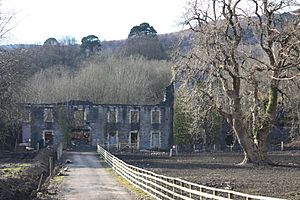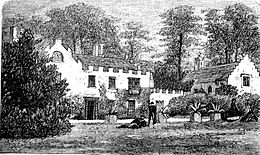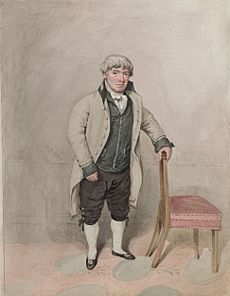Aberpergwm House facts for kids
Aberpergwm House (Welsh: Aberpergwm) is an old country house in Glynneath, Wales. It is now mostly a ruin. Near the house is St. Cadoc's Church. This church might be from the late medieval period, which means it is very old.
Contents
The House's Beginnings
The house you see today was built on top of an even older house. That house was called Neuadd Pergwm. Around the year 1560, the Williams family took ownership of the house. They were from a place called Blaen Baglan.
It is said that the famous leader Oliver Cromwell was related to the Williams family. Because of this connection, Aberpergwm House was saved. It was not destroyed during the English Civil War. The Williams family was one of the few important Welsh families. They were special because they stayed loyal to the Welsh language.
How the House Changed
By 1850, the house had some fun, castle-like decorations. It also had a central triangle-shaped part called a pediment. In 1876, the house was changed a lot again. This work was done by Morgan Stuart Williams. He later helped restore St Donat's Castle.
His changes in 1876 were very grand. He added a new front section to the house. This part had a huge, long room called a gallery. It was 94 feet long and went across the whole front of the house. This gallery was built to look like old Welsh halls. A new wing was also added along the hill. This wing also looked like a castle.
Before this, in 1868, Williams had said no to other plans. An architect named John Norton wanted to build a new house. It would have been in a fancy Gothic style with a tall tower. But Williams chose a simpler design instead. The house is built from strong stones. These are called Pennant Sandstone and Bath stone.
Later Years and a Fire
During the Second World War, a school moved to Aberpergwm House. This was the East Anglian School for Deaf and Blind Children. They came from Gorleston-on-Sea in Norfolk. They moved in the summer of 1940. This was because their old school was too close to the coast. It was not safe during the war. The school stayed at Aberpergwm House for the rest of the war.
After the war ended, the house was rented out. The National Coal Board used it as offices. The land around the house was used to mine for coal. Sadly, at some point, the house caught fire. It was badly damaged and was never rebuilt. The long gallery from 1876 collapsed. Now, only two floors of the front part remain. A small part of the third floor is still there.
Some old stone decorations from the original house were saved. They were later used in Penhow Castle. The Williams family still owns Aberpergwm House today.
Why It's Important
In the 1400s, Aberpergwm House was home to Rhys ap Siancyn. He and his family were big supporters of poets in Glamorgan. Dafydd Nicolas, a member of the Williams family, was one of the last Welsh bards. Bards were poets and singers who told stories. Another family member, Maria Jane Williams, collected Welsh folk songs. Her older brother, Rees Williams, helped start a bank.
The Williams family had a special saying, or motto. It was 'A ddioddefws a orfu'. In English, this means 'He who suffers triumphs'. This motto later became the motto for Glamorgan County Council.
Aberpergwm House is a Grade II listed building. This means it is an important historical building. It is being worked on to protect its history and structure. The fancy metal gates at the driveway are also listed as Grade II. The church nearby is being restored and is listed as Grade II*.
See Also
- St. Cadoc's Church, Glynneath
Images for kids











